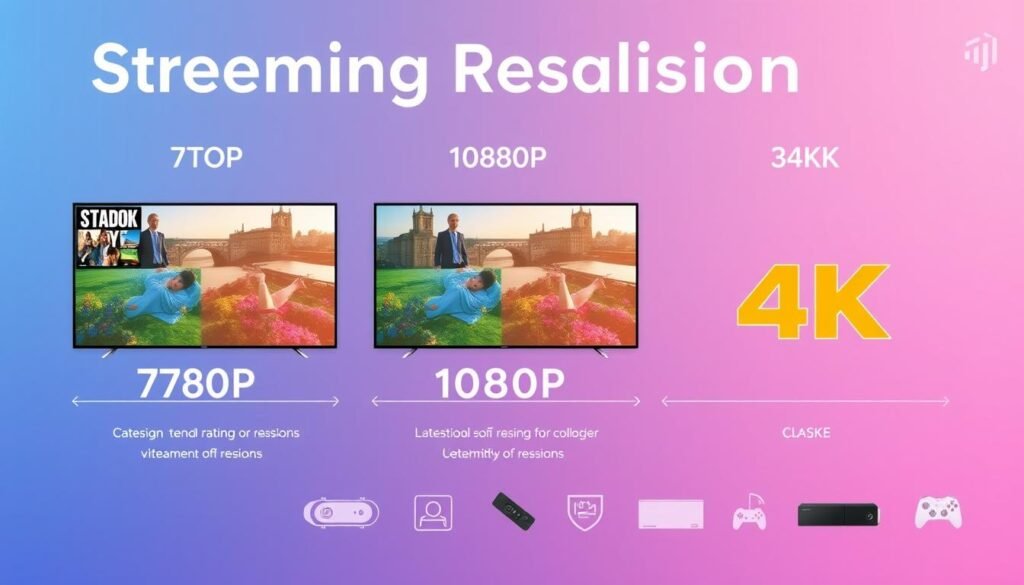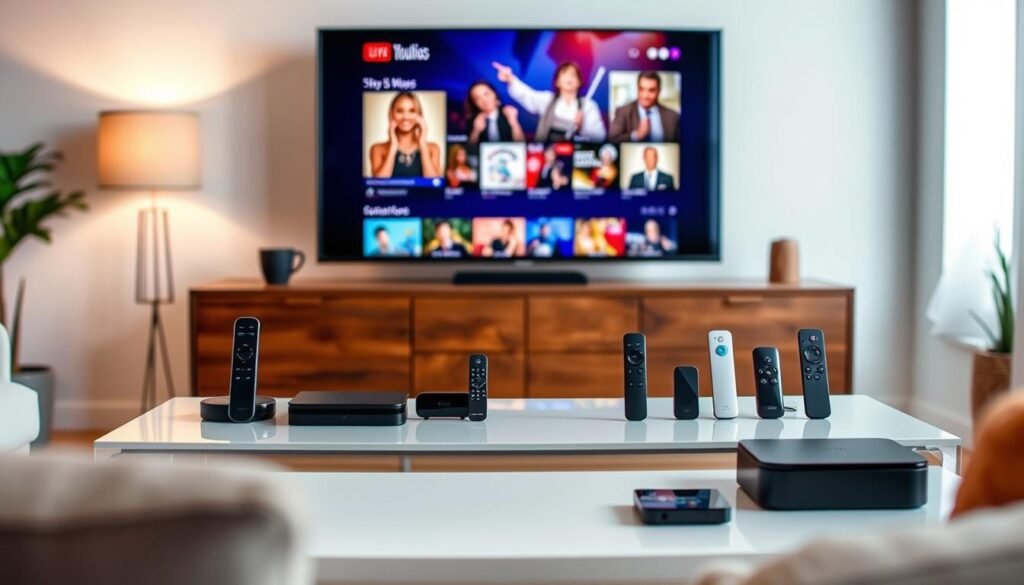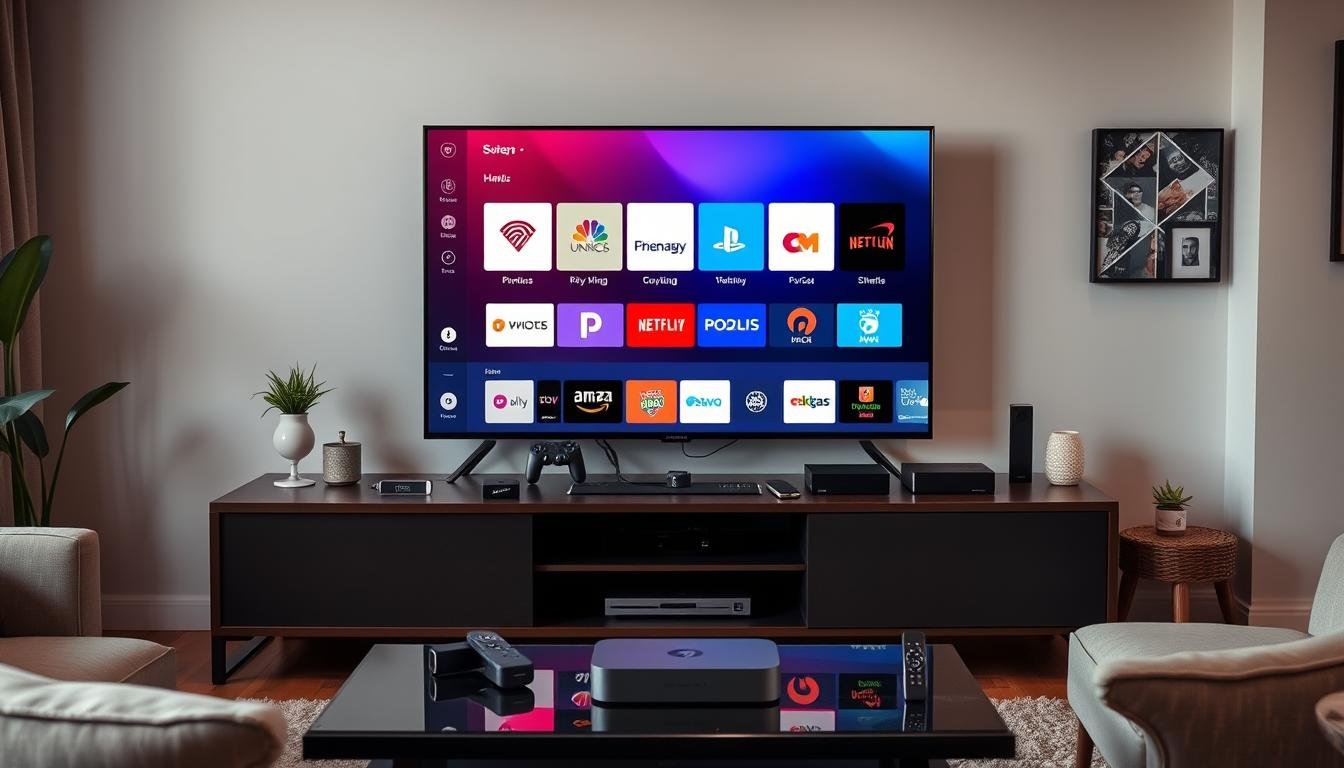“The future of television is not on television.” – Jaclyn Johnson’s words ring true as we dive into the world of affordable streaming devices. These compact powerhouses are revolutionizing how we consume media, turning ordinary TVs into smart entertainment hubs.
In 2024, the market is brimming with options for those seeking to upgrade their viewing experience without breaking the bank. From crystal-clear 4K streaming to voice-controlled interfaces, these devices pack a punch while keeping costs low.
Let’s explore the top affordable streaming devices that can transform your TV into a gateway to endless entertainment. Whether you’re a movie buff, a series binger, or a casual viewer, there’s a perfect streaming solution waiting for you.
Key Takeaways
- Affordable streaming devices offer smart TV features at a fraction of the cost
- Popular options include Amazon Fire TV Stick Lite, Roku Express 4K+, and Google Chromecast
- 4K streaming capability is becoming standard in budget-friendly devices
- Voice control features enhance user experience and ease of navigation
- Compatibility with major streaming platforms ensures access to diverse content
- Regular firmware updates keep devices current with new features and services
Introduction to Affordable Streaming Devices
Streaming devices have revolutionized how we consume media, offering a gateway to endless entertainment. These compact gadgets connect to your TV, transforming it into a smart entertainment hub. Let’s explore what streaming devices are and why they’ve become so popular.
What Are Streaming Devices?
Streaming devices are small, powerful gadgets that plug into your TV’s HDMI port. They use high-performance SSDs to store apps and cache data, ensuring smooth playback. These solid state drives enable quick boot times and fast app loading, enhancing your viewing experience.
Benefits of Using Streaming Devices
Streaming devices offer numerous advantages:
- Access to vast content libraries
- Cost-effective alternative to cable
- Upgrade older TVs with smart features
- Personalized viewing recommendations
- Portability for use in different locations
With streaming devices, you can enjoy your favorite shows and movies on demand. They’re perfect for cord-cutters looking to save money without sacrificing entertainment options. The solid state drives in these devices ensure quick access to your content, minimizing buffering and load times.
| Feature | Benefit |
|---|---|
| High-performance SSDs | Fast boot and app loading |
| Wi-Fi connectivity | Stream content anywhere in your home |
| Voice control | Easy navigation and search |
| Regular updates | Access to latest features and apps |
By incorporating streaming devices into your home entertainment setup, you’re opening the door to a world of content at your fingertips. The combination of high-performance SSDs and user-friendly interfaces makes these devices a must-have for any TV enthusiast.
Top Affordable Streaming Devices in 2024
In 2024, streaming devices have become essential for home entertainment. With advancements in fast data storage and NVMe SSDs, these devices offer smooth performance at budget-friendly prices. Let’s explore the top affordable options that bring smart features to your TV.
Amazon Fire TV Stick Lite
The Fire TV Stick Lite packs a punch for its price. It supports Full HD streaming and comes with Alexa Voice Remote Lite. While it lacks TV controls, it offers access to thousands of channels and apps. Its compact design makes it perfect for those with limited space behind their TVs.
Roku Express 4K+
Roku Express 4K+ delivers 4K streaming capabilities at an affordable price point. It boasts a user-friendly interface and supports major streaming services. The device utilizes NVMe SSDs for fast data storage, ensuring quick app launches and smooth navigation.
Google Chromecast with Google TV
Google’s offering combines the simplicity of Chromecast with a full-fledged Android TV experience. It supports 4K HDR content and comes with a voice remote. The integration with Google Assistant makes it a powerful hub for smart home control and content discovery.
| Device | Max Resolution | Voice Control | Price Range |
|---|---|---|---|
| Fire TV Stick Lite | 1080p | Alexa | $20-$30 |
| Roku Express 4K+ | 4K | Roku Voice | $30-$40 |
| Chromecast with Google TV | 4K HDR | Google Assistant | $40-$50 |
Each device offers unique features to enhance your streaming experience. Consider your specific needs and TV compatibility when choosing the best option for your home entertainment setup.
How to Choose the Right Streaming Device
Picking the perfect streaming device can be tricky. With so many options available, it’s important to focus on what matters most to you. Let’s explore the key factors to consider when making your choice.
Consider Your Content Preferences
Think about the shows and movies you love. Different streaming devices support various apps and services. If you’re a fan of high-performance content, like those streamed from PCIe SSDs or enterprise SSDs, make sure your device can handle it.
Check Compatibility with Your TV
Not all streaming devices work with every TV. Check your TV’s ports and resolution. Some devices require HDMI, while others might need USB. If you have a 4K TV, look for a device that supports 4K streaming to make the most of your screen.
Look for User-friendly Features
Easy navigation is key for a good streaming experience. Look for devices with simple remote controls and intuitive interfaces. Voice control can be a game-changer, allowing you to find content quickly without typing.
- Easy-to-use remote control
- Clear and simple menu layout
- Voice search capability
- Quick app switching
Remember, the best device for you balances your content needs, TV compatibility, and ease of use. Take your time to compare options and read reviews before making your decision.
Streaming Quality and Performance
Streaming quality can make or break your viewing experience. To get the most out of your affordable streaming device, it’s crucial to understand how resolution and internet speed work together.
Importance of Streaming Resolution
Resolution determines the clarity of your streamed content. Most devices offer 1080p HD, while some support 4K Ultra HD. Higher resolution means sharper images, but it also requires more bandwidth. For the best performance, streaming devices often use high-endurance SSDs for smooth playback and quick load times.

Understanding Internet Bandwidth Requirements
Your internet speed plays a vital role in streaming quality. For 1080p content, you’ll need at least 5 Mbps. 4K streaming demands 25 Mbps or more. Low-latency storage in streaming devices helps buffer content efficiently, reducing lag and stuttering.
| Resolution | Minimum Speed | Recommended Speed |
|---|---|---|
| 720p | 3 Mbps | 5 Mbps |
| 1080p | 5 Mbps | 10 Mbps |
| 4K | 25 Mbps | 50 Mbps |
Remember, these are per-device requirements. If multiple devices are streaming simultaneously, you’ll need higher speeds. Check with your internet service provider to ensure you have the right plan for your streaming needs.
Popular Platforms Supported by Streaming Devices
Streaming devices offer access to a wealth of content through various platforms. These platforms leverage high IOPS SSDs and fast data storage to deliver seamless streaming experiences. Let’s explore some of the most popular streaming services compatible with affordable devices.
Netflix and Hulu
Netflix and Hulu are staples in the streaming world. Netflix boasts a vast library of original content and licensed shows, while Hulu offers current TV episodes and a growing collection of originals. Both platforms utilize advanced technology to ensure smooth playback, even during peak viewing hours.
Disney+ and ESPN+
Disney+ has quickly become a favorite for families and fans of Marvel, Star Wars, and Pixar. It partners with ESPN+ to provide a comprehensive entertainment package. These services rely on fast data storage solutions to handle the high demand for their exclusive content.
Amazon Prime Video
Amazon Prime Video comes bundled with Amazon Prime subscriptions, offering a mix of original series, movies, and additional channels. Its integration with Amazon’s ecosystem makes it a convenient choice for many users. The platform’s infrastructure includes high IOPS SSDs to manage its extensive catalog efficiently.
| Platform | Original Content | Live TV Option |
|---|---|---|
| Netflix | Yes | No |
| Hulu | Yes | Yes |
| Disney+ | Yes | No |
| ESPN+ | Yes | Yes |
| Amazon Prime Video | Yes | Yes (with add-ons) |
These platforms continue to innovate, offering 4K streaming and offline viewing options. Their compatibility with affordable streaming devices makes high-quality entertainment accessible to a wide audience.
User Experience and Interface
Streaming devices offer a gateway to endless entertainment, much like how solid state drives revolutionized data storage. The user interface plays a crucial role in how we interact with these devices, similar to how NVMe SSDs enhance system responsiveness.
Navigating Through Streaming Menus
Modern streaming devices boast intuitive menus that make content discovery a breeze. Users can effortlessly browse through categories, search for specific titles, or explore recommended shows. The smooth navigation experience is comparable to the speed boost solid state drives provide to computers.
Voice Control Features
Voice control has become a game-changer in the streaming world. Users can now search for content, control playback, and even adjust settings using voice commands. This hands-free approach to navigation is as revolutionary as NVMe SSDs were to data transfer speeds.
- Search for shows or movies by title, actor, or genre
- Control playback (play, pause, rewind, fast-forward)
- Adjust volume and other settings
- Launch specific apps or channels
The seamless integration of voice control in streaming devices mirrors the effortless performance boost that solid state drives bring to computing tasks. As technology advances, we can expect even more intuitive interfaces and features that will further enhance our streaming experience.
Streaming Device Connectivity Options
Streaming devices offer various connectivity options to enhance your viewing experience. While PCIe SSDs and high-performance SSDs are crucial for computer storage, streaming devices focus on different connection types for optimal performance.
Wi-Fi vs. Ethernet
Wi-Fi and Ethernet are the primary connection methods for streaming devices. Wi-Fi offers convenience and flexibility, allowing you to place your device anywhere within range. Ethernet, on the other hand, provides a more stable and faster connection, ideal for streaming 4K content.
| Connection Type | Pros | Cons |
|---|---|---|
| Wi-Fi | Wireless, flexible placement | Potential interference, slower speeds |
| Ethernet | Stable, faster speeds | Requires cable, limited placement |
Bluetooth Connectivity Benefits
Bluetooth connectivity in streaming devices offers several advantages. It allows you to connect wireless headphones or speakers, enhancing your audio experience. This feature is particularly useful for late-night viewing or when you need privacy.
Some streaming devices even support Bluetooth keyboards, making text input and navigation easier. While not as critical as PCIe SSDs for data transfer, Bluetooth adds convenience to your streaming setup.
- Connect wireless audio devices
- Use Bluetooth keyboards for easier navigation
- Enjoy private listening without disturbing others
By understanding these connectivity options, you can choose a streaming device that best fits your needs and home setup.
Budget Considerations for Streaming Devices
When shopping for streaming devices, pricing plays a crucial role. Let’s explore the cost ranges and ways to save on these entertainment essentials.
Pricing Ranges Explained
Streaming devices come in various price points, catering to different budgets and needs. Entry-level options start around $30, offering basic features suitable for most users. Mid-range devices, priced between $50 and $100, often include advanced capabilities like 4K streaming and voice control. Premium models can exceed $100, boasting features similar to enterprise SSDs with low-latency storage for smoother performance.
| Price Range | Features | Example Devices |
|---|---|---|
| $30 – $50 | Basic streaming, 1080p resolution | Roku Express, Fire TV Stick Lite |
| $50 – $100 | 4K streaming, voice control | Chromecast with Google TV, Roku Streaming Stick+ |
| $100+ | High-end features, gaming capabilities | Apple TV 4K, NVIDIA Shield TV Pro |
Finding Deals and Discounts
To score the best prices on streaming devices, keep an eye out for seasonal sales events like Black Friday and Cyber Monday. Many retailers offer significant discounts during these periods. Subscribe to manufacturer newsletters for exclusive deals and consider refurbished models for additional savings. Some cable providers bundle streaming devices with their services, potentially offering a cost-effective solution.

Remember, while enterprise SSDs and low-latency storage technologies enhance performance in high-end models, most users find budget-friendly options perfectly suitable for everyday streaming needs.
Future-Proofing Your Streaming Device
Staying ahead in the streaming world means thinking about tomorrow. Your device should handle new services and tech easily. Let’s explore how to keep your streaming setup ready for what’s next.
Support for Upcoming Streaming Services
The streaming landscape changes fast. New platforms pop up often. Your device needs to adapt. Look for ones that promise support for emerging services. This ensures you won’t miss out on fresh content.
Some devices use tech similar to high-endurance SSDs. These can handle constant data flow better. They’re built to last, just like high IOPS SSDs in data centers. This means smoother streaming for longer.
Updates through Firmware
Regular updates keep your device fresh. Firmware updates add features and fix bugs. They’re key to long-term performance. Choose a brand known for consistent updates. This keeps your device running smoothly for years.
| Feature | Benefit |
|---|---|
| Firmware Updates | New features, bug fixes |
| High-endurance Components | Longer device lifespan |
| Expandable Storage | Room for new apps |
Remember, a future-proof device isn’t just about specs. It’s about flexibility and support. Choose wisely, and you’ll enjoy streaming for years to come.
Setting Up Streaming Devices
Setting up your new streaming device is a breeze. With fast data storage and solid state drives becoming more common, these devices boot up quickly and offer smooth performance. Let’s walk through the setup process and tackle some common issues.
Simple Setup Steps
Follow these steps to get your streaming device up and running:
- Plug the device into your TV’s HDMI port
- Connect the power adapter
- Turn on your TV and select the correct HDMI input
- Follow on-screen instructions to connect to Wi-Fi
- Sign in to your streaming accounts
Troubleshooting Common Issues
Encountering problems? Try these solutions:
| Issue | Solution |
|---|---|
| No picture | Check HDMI connection and TV input |
| Wi-Fi won’t connect | Reset router or move device closer |
| Slow performance | Clear cache or check internet speed |
| Remote not working | Replace batteries or re-pair with device |
Remember, solid state drives in modern streaming devices can help reduce loading times and improve overall performance. If you’re still facing issues, consult the manufacturer’s support website or contact their customer service for further assistance.
Enhancing Your Streaming Experience
Streaming devices offer more than just access to your favorite shows. They can transform your living room into a smart entertainment hub. Let’s explore how to maximize your streaming device’s potential.
Integrating Smart Home Features
Modern streaming devices often come with built-in smart home capabilities. You can control your lights, thermostat, and even security cameras using voice commands through your streaming remote. This integration creates a seamless home entertainment experience, similar to how NVMe SSDs enhance computer performance.
- Set up voice control for hands-free operation
- Link compatible smart home devices to your streamer
- Create custom routines for movie nights
Using Apps and Subscriptions Effectively
To get the most out of your streaming device, organize your apps and subscriptions strategically. Just as PCIe SSDs optimize data transfer, efficient app management can streamline your viewing experience.
| Tip | Benefit |
|---|---|
| Group similar apps together | Quick access to content |
| Use watchlists across platforms | Never lose track of shows |
| Set up profiles for family members | Personalized recommendations |
“A well-organized streaming setup can save you time and enhance your viewing pleasure, much like how an optimized computer system improves productivity.”
By integrating smart features and managing your apps effectively, you’ll create a more immersive and enjoyable streaming experience. Remember to regularly update your device’s firmware to ensure you have access to the latest features and improvements.
Conclusion: The Best Value for Your Money
Finding affordable streaming devices can transform your TV into a smart entertainment hub. We’ve explored several options that offer great features without breaking the bank.
Recap of Recommended Devices
The Amazon Fire TV Stick Lite stands out for its user-friendly interface and Alexa integration. Roku Express 4K+ impresses with its wide range of channels and 4K streaming capabilities. Google Chromecast with Google TV shines with its intuitive recommendations and seamless integration with other Google products.
Final Thoughts on Affordable Options
These affordable streaming devices offer excellent value for money. They bring a world of entertainment to your fingertips, turning any TV into a smart hub. When choosing, consider your content preferences, TV compatibility, and desired features. With these budget-friendly options, you can enjoy high-quality streaming without overspending.
